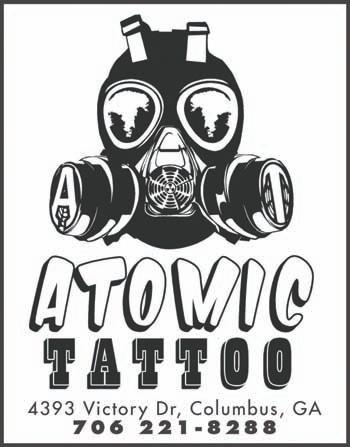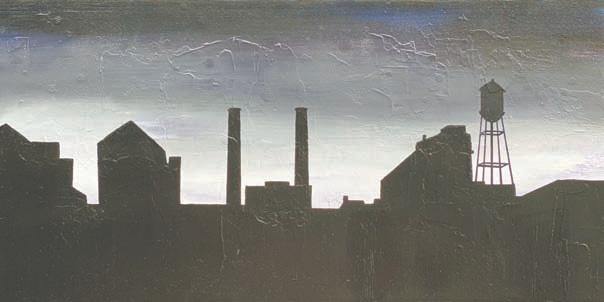
8 minute read
ENA RAMILLE’S "Twenty Five" ~ Mixes Architecture, History, & Culture
Header artwork by Ena Ramille - Columbus Skyline
A CULMINATION OF MY JOURNEY TO COLUMBUS
By Erick Richman
Celebrating 25 years since she left Puerto Rico behind and began finding her place in mainland America, Ena Ramille Quiñones’s art show “Twenty Five: A Culmination of My Journey to Columbus” brings together the past, present and future, inviting others to see Columbus, Georgia’s culture and architecture through the lens of her experience.
“To me the old things are sacred,” she says, “so we should be able to share that with future generations in a way that they can relate to and see themselves in.”
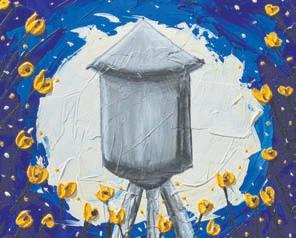
Starry Night Water Tower
She paints with an awareness of the way cultures mingle, shift and grow over time, mixing line drawings, paint and texture to reflect the diversity of the area’s history. From her own background in the culturally diverse island of Puerto Rico to the complex – and often painful – history of the American South, her canvasses show her journey through the inspiration she’s found in the world around her.
Embracing mixed media allows her to avoid, as she puts it, being placed “inside a box.” Similarly, she rejects the idea that art should be “behind the glass somewhere in a museum or gallery.” Rather, she says “I want you to feel the texture, hold it, have a complete sensory experience.”
One of her most frequent subjects is local architecture, especially buildings from the late 1800s and early 1900s.
“Some people have lived here all their lives, but they don’t see the rich history of Columbus and how Columbus came to be,” she says.
Her art seems fascinated with the history of buildings in the area, how that history is often obscured, and the vibrancy that has sprung up around and within the structures of the past.
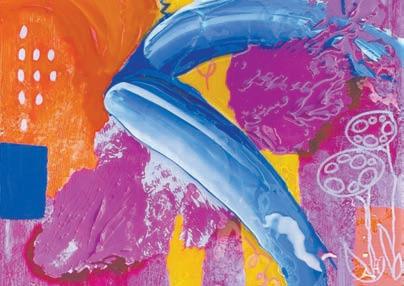
Electric Slide 1; Mixed Media With Resin
She credits her father, a telephone company draftsman back in the 1970s Puerto Rico of her childhood, for teaching her to be keenly and deeply aware of the built environment around her.
He would tell her, “Look at the structure, the history,” teaching her to always “admire and absorb what each building is about.”
She speaks of her father with memories of Puerto Rico, where she lived until she was a college sophomore. Her relocation to a new place – and a new culture – came just a few years after the death of her father from complications due to diabetes.
As a young child, it was impactful. While many people engage with buildings only passively, walking through them, her father’s deeply intimate connection with the structures of her childhood left a lasting impression on her. He taught her that “buildings are part of the history of what and who we are.”
Today, her art brings her closer to the past, and the memories of the man who taught her the value of being present and appreciating the world around her.
“That’s the same way I feel when I’m here in Columbus,” she says, crediting the vibrancy of today’s revitalized downtown with inspiring her to reflect and create. “When I’m walking around [here], it brings back my childhood memories … it’s very dear in my heart when I see families with children and bicycles running around downtown.”
Initially unaware of how vibrant and diverse Columbus’ art scene was, she said she came to realize how many “colorful people” there are in the area, and how their art contributes to a thriving, connected community.
Alongside the inspirational power of the community, she points out that the stability she has found in Columbus is what truly allowed her to express herself.
“I’ve been a worker with no skills, no education, no English,” she says, recalling the experience of leaving her home as a college sophomore decades ago. Today, having finished her master’s degree and married, she is building a reliable career in mortgage finance. Suddenly able to look back on her life, she has taken inspiration from the community and been able to express her experience through art; although it wasn’t her first brush with being creative.
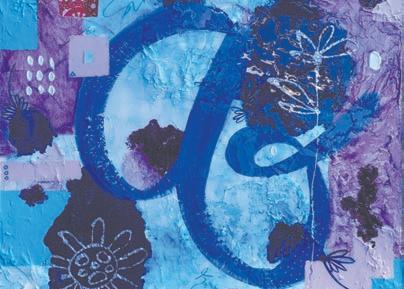
Royal Ladies- Beatrice; Mixed Media With Resin
“Twenty years ago,” she says, ”I wanted to be a graphic designer.” She studied commercial art in college, but found that – as a young Latina woman lacking experience, opportunities and connections – she had to put her artistic endeavors on hold.
Now, looking back, she’s adamant that art is not a personal endeavor, but a community one. Simultaneously deeply personal and public, art reminds us of the interconnectedness of our world.
“You can connect with people once you start talking to them,” she says, which is precisely how her show, “Twenty Five,” came about.
Walking down 2nd Avenue, Ena Ramille became “enamored” with the 1891 building which currently houses Latin American restaurant Bodega 1205 (12th Ave & 1st). She kept going back “to experience the building,” drawing the attention of Cesar Bautista, the owner, who shared her admiration for architectural design. That encounter led to a partnership founded in their shared background and sense of cultural appreciation.
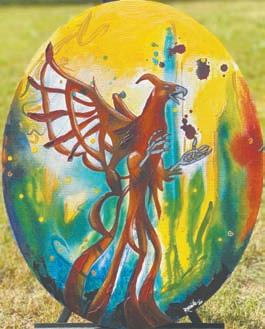
Fenix en Broadway
“There’s always a way to connect with people, whether it’s through art, whether it’s through food… Food is a magical way to connect people. So that is one of the reasons why the owner of Bodega 1205 and I get along so well. He's also serving food, selling art and supporting artists.
During the show itself, the food of Bodega 1205 and the live guitar of Mateo Vintimilla, a music performance graduate student at CSU, combined to create the “complete sensory experience” she was going for. Even on nights there is no live music, her art is permanently displayed – and available for sale – at Bodega 1205.
“To me that was part of the experience, you come in, you start looking at the art, while you’re looking at the art you start smelling the food, hearing the music of the region…”
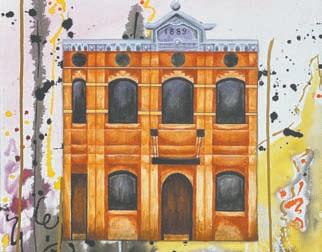
Mabella's
That openness to exploring the world of others is vital experience through the building, creating contrast and to artists seeking support, she says.
“Once they start seeing what you’re doing, paintings or any other projects, that person that you’ve connected with will want to support you.”
“Art nurtures people, helps them to be creative,” she says.
Prior to holding her first solo show at Bodega 1205, Ena Ramille connected with proprietor Karen Ouzts and began displaying her artwork at the Heritage Art Center (541 2nd Avenue). Today, the Heritage Art Center is in the process of growing, expanding with the renovation of a nearby building to create more spaces for artists to gather and create, which Ena calls a “perfect opportunity” for other artists in the area to join in on the local community.

Columbus Sunset 2
“Art is essential in our lives,” Ena says. “People are not meant to just get up and go to work and get home and that's it."
That sense of resilient vibrancy is present throughout her art; the support of the community has helped her to connect to her own experience of loss and searching. "You can put a lot of emotion down, "she says, of expressing grief through art, "Every scratch, every texture on the canvas, is, to me, the one time I'm able to touch my dad."
"All the times I held his hand, when he used to pick me up, he would hold my hand the whole way home. That's what I come to, that's what I think about," she says.
"The feeling of touch is so underrated".

Cafeteras
at Bodega 1205
A sampling of the works available for sale at Bodega 1205 is available on her website, artbyenaramille.com, as are links to her Etsy and Society6 stores, which feature her artwork on personal items and home décor. Her art is also currently on display at the Heritage Art Center in Columbus.
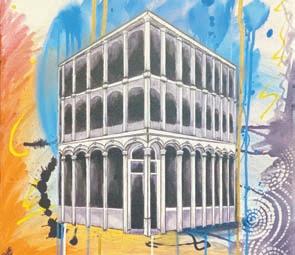
Iron Bank
artbyenaramille.com/collections/twenty-five-the-collection/ products/iron-bank-building
Ena Ramille Quiñones’ depiction of the Iron Bank building in downtown Columbus, GA is representative of her artistic approach, mixing different styles to reflect the complexity of history and culture. The rough, scratchy pen lines of the building call back to the process and time of its construction, while also echoing her father’s work as a civil engineer and the reverence for everyday structures he instilled in her.
The darkness in the windows and lack of signage, she says, is to avoid limiting the building to “being one thing,” to existing only at one time. Instead, the unadorned windows allow for the building to simultaneously be what it once was, what it is today and what it might be in the future. Surrounding the subdued depiction of the building is a vibrant cascade of color of many types, directions and textures. Inspired by the dramatic angle of the original photo of the building by Andy Funderburk, she used the mixed media approach to explore her own experience through the building, creating contrast and depth that reflects the stories of the home she left behind and the community she has found.
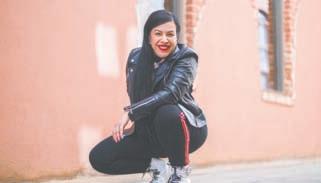
ENA RAMILLE
Photo by Trey Walker
